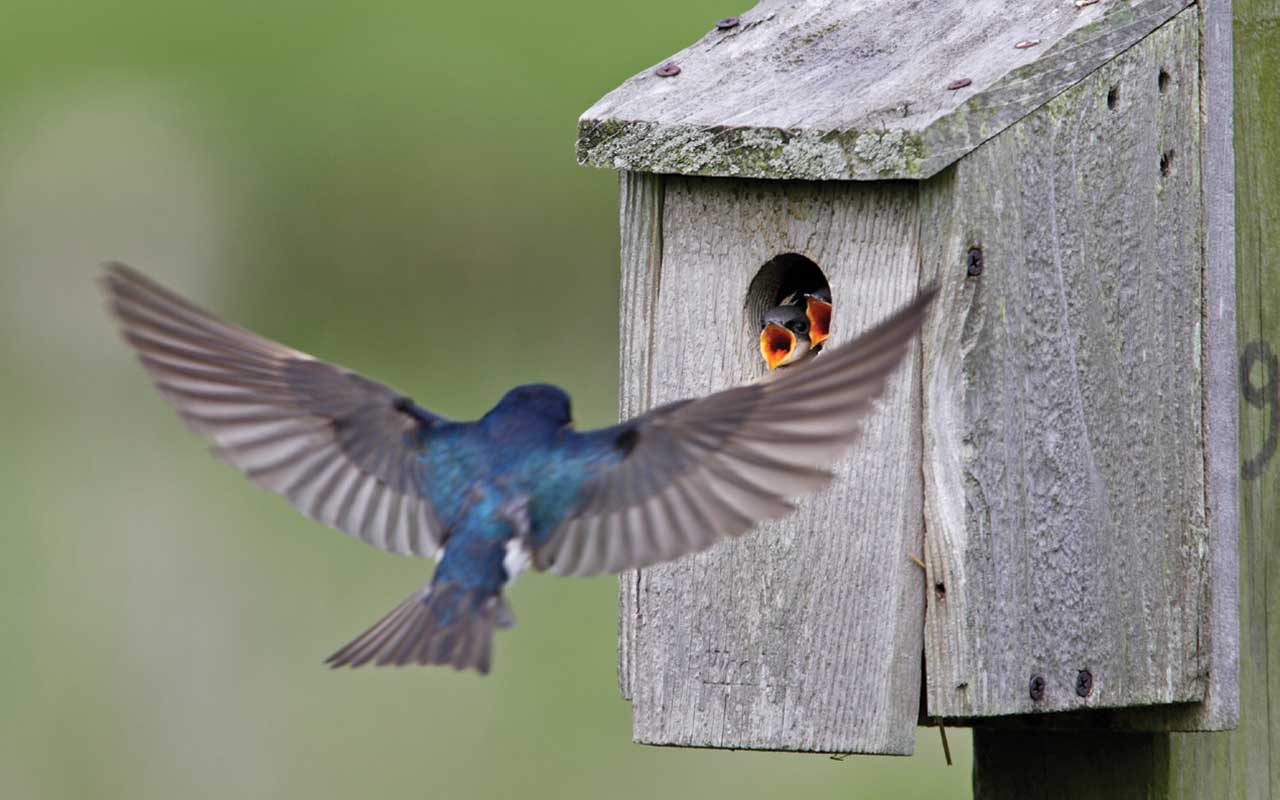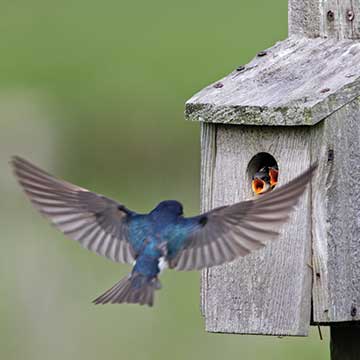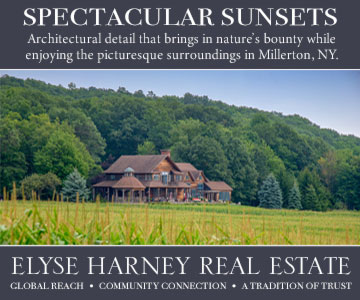Real Estate

Housing for the Birds
Reflecting on a subject for an article dealing with real estate and animals, I realized that the same considerations humans have when selecting a home are also true in the avian world – security, construction, location, room layout, finishes, etc. The realtors’ view that there is always the right client for a house applies to birds as well, so I consulted with birdhouse experts to provide readers with the information required to consider starting their own backyard real estate development project and become a responsible landlord. Unlike human habitats, there are no regulations and no leases to sign.
Housing shortage
Nationally there is a housing shortage in most parts of our country. The same is true for many of our bird neighbors as trees are cut down, open agricultural fields are developed or returned to forest, people move in and the natural landscape becomes fragmented. Birdhouses, at least for some species that make their nests in the cavities of trees, provide needed shelter, especially during hatching session. A national effort to save bluebirds by building and installing bluebird houses has turned around their population decline. Purple martins nest almost exclusively in housing provided by humans and are declining in our region.
 Air–b–&–bird?
Air–b–&–bird?
Songbirds are seasonal tenants and many don’t show up until spring to look for a house to raise their young. They move from one house to another after their fledglings have left the nest and then may resettle for the next clutch before migrating south for the winter. Most birdhouse tenants don’t buy and settle down in the same place year after year to increase the chances of the vulnerable young surviving. Like people running out on their rent, they have moved on to the next spot.
Location, location, location
When it comes to looking at houses, each bird species is very particular and very practical. In general the best address must be sheltered from wind and rain and be out of the reach of predators. Birdhouses should not be located in areas where pesticides have been used as it poisons the insects that birds feed on. Commercially cultivated fields and golf courses should be avoided, but again each species has their own idea about a good neighborhood.
Waterfront real estate is desired by wood ducks whose natural nesting place is in old growth and mature hardwoods. But nailing a wood duck box on a random tree near your pond may do more harm than good. The box needs to face open water and be at least four to six feet above the high water line, a 100 feet from other boxes and in shallow water to prevent large mouth bass swallowing ducklings as they emerge from the box. Bluebirds want to face as much sun as possible and look out on an open space away from the prevailing wind. Of course, like most people, birds like to be close to dining. Native plant gardens that attract insects also attract birds that dine on insects.
Purple martins are even more demanding. They prefer to stick together in a multi-family house 12’ to 18’ off the ground in an open area with clear flyways 30 to 120 feet from human housing and 60 feet from trees.
Curb appeal attracts the right kind of tenant
Each species of bird has specific requirements that attract them to a new home. All birds seem to prefer untreated, unpainted wood, preferably cedar, pine, or cypress. Bright colors attract predators. Roofs should be sloped and overhang the sides and front of the house. Smart birds know that perches are a bad idea as they make it easier for predators to enter. Many fanciful birdhouses that are widely available are the equivalent of Big Mac houses – too fancy, too big, and not very practical.
Housing discrimination
There are building specifications for each species of bird from owls to titmice. And like any other kind of residential project you need to build to suit the market. For example bluebirds need a 1.5” hole 6” to 10” above the house floor. The interior space should be 5” by 5” to accommodate broods of five to eight chicks. Barn swallows prefer open boxes that are set up in sheltered areas close to a mud source. In contrast barn owls select open areas close to hollow trees, cliffs, riverbanks, or barns with lots of rodents. These large birds require a 3¾” to 4 ½” elliptical hole. Tiny birds like wrens and chickadees need a tiny opening of only 1 1/8.”
Avoid home invasions
Sparrows and starlings, both invasive species imported from the UK in the late nineteen century, will enter unprotected birdhouses and kill fledglings. Protect residents with Noel predator guards – metal mesh cages that fit around the entrance to keep predators including cats, weasels, raccoons, and snakes out of the nest box. The right sized hole for a bluebird will keep out starlings but not sparrows. If your house is mounted on a pole you might need a wide cone or a baffle to prevent predators from climbing up into the house. And be sure that these home invaders can’t drop from above. Domestic house cats kill an estimated 500 million birds a year. Please keep them safe inside your own house.
Birds do not need heat or central A/C but a staircase is helpful
The interior of the birdhouse is just as important as the exterior to avian lookers. The walls should be at least ¾” thick for insulation. While central A/C is not important, ventilation is required – just a few small-drilled holes near the top of each side and some holes in the bottom to prevent flooding. Since these nest boxes or birdhouses are primarily for hatching, protecting, and then launching the young the interior wall below the entrance hole should have grooves like a ladder to help nestlings get out of the house. You’ve heard of “failure to launch.”
Spring is the time to put your house on the market
Just like humans most birds start looking around for a house in mid to late March and it should be ready for showing by March 1. Like houses for sale, it may take a while for the right bird to find you.
Staging
From a bird’s perspective while the size, location, and type of house and its entrance are important; different species also have preferred interiors. For example ducks and woodpeckers like a layer of wood shavings when they move in to provide warmth and a cushion for eggs, while most songbirds bring their own furnishings to a clean house.
Annual maintenance is required
Just like any investment property most birdhouses require annual maintenance and cleaning. Sharon’s Audubon Center suggests that all birdhouses be cleaned on March 1 and it’s a good idea to wear a facemask and gloves for this annual task. Easy access to the interior is important – it seems like a shop vac might come in handy.
Consult an expert
Just as you would hire an architect to build a house, you should search out up-to-date sources on the habits and preferences of the kind of bird you want to attract before buying, building, or siting a birdhouse. Bats, for example, have been decimated by white nose disease and need help. They prefer to be near water with a large, flat house mounted on a pole or affixed to the side of a building facing the sun. At sunset, as they emerge from their house, you can enjoy them diving in midair and devouring insects. Providing them with a proper home can help keep bats out of your house.
Over 81 million people in the US feed birds and watch wildlife from their own homes. It’s an affordable, increasingly popular activity that provides a glimpse into the behavior of a mysterious presence that flies in and out of our daily routine. In our region there are still songbirds living amongst us, but far fewer than even ten years ago. Feeding and sheltering birds are small ways for us all to stay in touch with our immediate environment and make a small change. The return on investment is incalculable. •
Christine Bates is a real estate agent with William Pitt Sotheby’s International Realty and has written about real estate since the first issue of Main Street Magazine in 2013.





